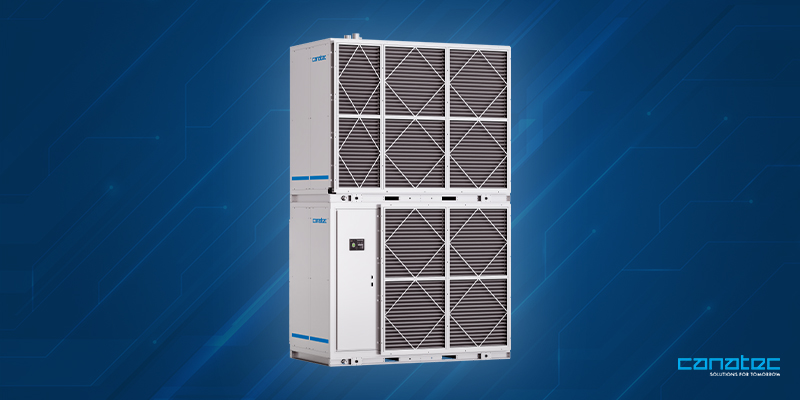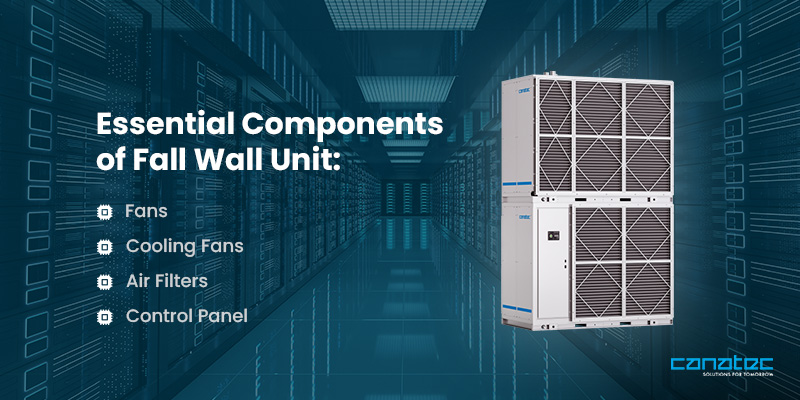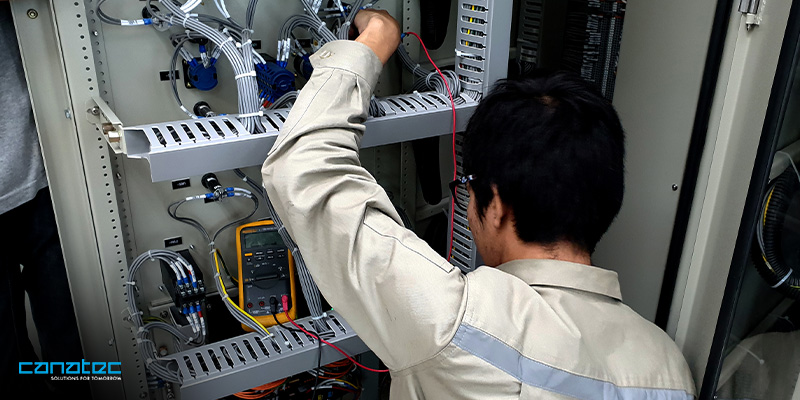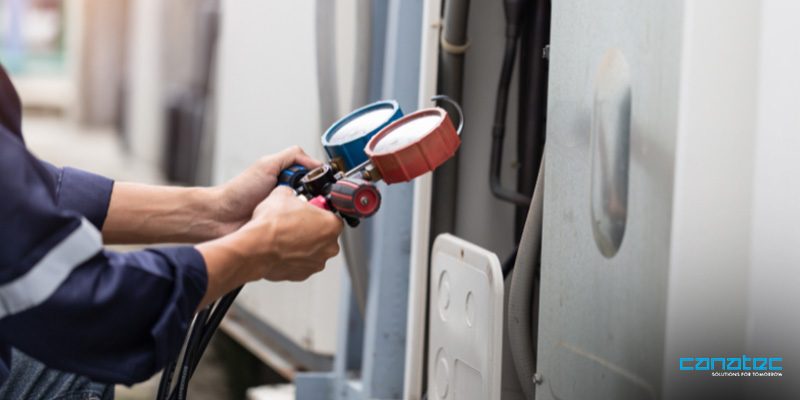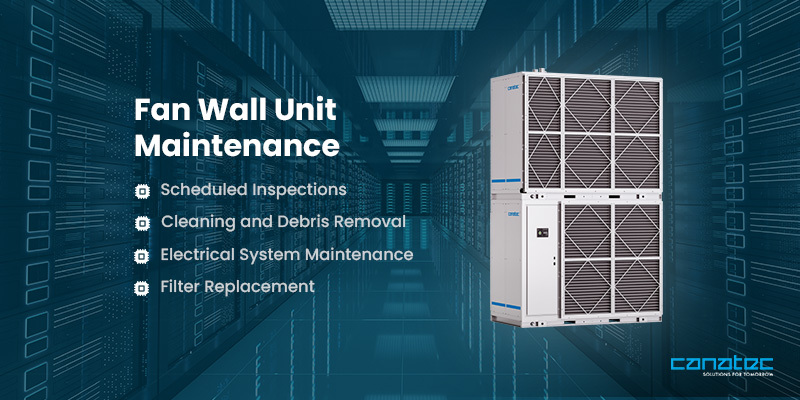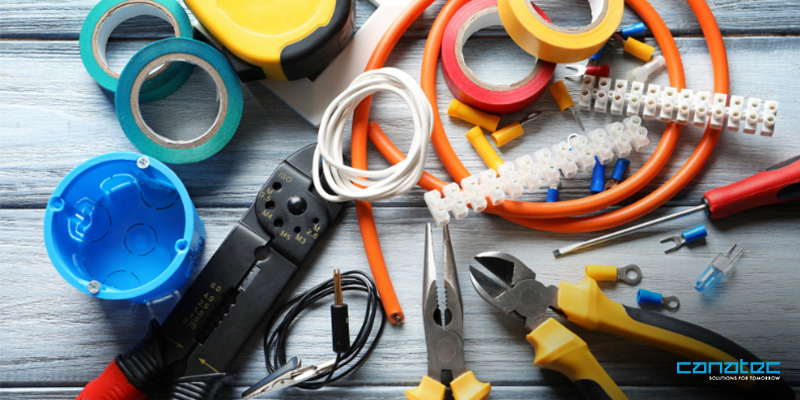A Comprehensive Guide to Fan Wall Unit
Table of Contents
PART 1 – INTRODUCTION
Due to their versatility and easy controllability, fan wall units are rapidly gaining popularity in hyperscale data centre settings as highly efficient cooling solutions. Typically installed in commercial and industrial environments, these innovative systems are organised in a grid pattern to optimise air circulation. Often mounted on floor in rows with no raised floor required to form a containment-like wall, they excel at cooling expansive areas, making them ideal for settings where maintaining a stable temperature is crucial. As businesses and industries seek more effective cooling solutions, this article aims to explore the fundamentals of fan wall units to give you a better understanding of their functionality.
PART 2 – GETTING TO KNOW FAN WALL UNITS
2.1 Essential Components of Fall Wall Units
Fan wall units are sophisticated systems designed to provide efficient cooling for large spaces, such as commercial buildings, industrial environments, and hyperscale data centres in Singapore. To understand how they achieve optimal performance, it’s vital to first explore their key components.
1. Fans
In fan wall units, multiple fans are strategically arranged in a grid pattern to circulate air throughout the space. This layout positions each fan to target a specific section, reducing overlap and eliminating gaps to ensure consistent air distribution.
2. Cooling Coils
Cooling coils play a pivotal role in the heat exchange process in a unit. After extracting heat from the air as it passes through the unit, the coils expel the cooled air back into the space to keep the environment at the desired temperature.
3. Air Filters
Air filters trap and remove dust, allergens, and other particles from the air before it is recirculated into the space. This improves indoor air quality, which is especially important in data centres where clean air is essential for the proper functioning of sensitive equipment.
4. Control Panel
The control panel allows users to adjust fan speeds, temperature, alarm monitoring, and other settings of fan wall units. Modern control panels may feature programmable timers for automated system control based on schedules. Additionally, users can use a Building Management System (BMS) or Data Center Infrastructure Management (DCIM) to manage the unit.
2.2 Proper Sizing of Fan Wall Units
Proper sizing of fan wall units contributes to effective cooling and energy efficiency. Now that we have explored the fundamentals, the next step is to consider the factors that determine the correct size for optimal performance.
1. Room Size
The size of the unit depends on the dimensions of the room where it will be installed. Calculating the cubic footage of the space aids in selecting a unit capable of efficient air circulation. Larger facilities naturally require units with higher airflow capacity to achieve comprehensive cooling across the entire area, while smaller ones may opt for those with reduced airflow capacity.
2. Insulation and Ventilation
The level of insulation and the effectiveness of ventilation systems in the room can also impact the cooling requirements. Well-insulated spaces with efficient ventilation reduce the heat load on the fan wall unit. Conversely, poorly insulated rooms or inadequate ventilation increase the unit’s workload, requiring a larger capacity for effective cooling.
3. Heat Load
Equipment in data centres generate a large amount of heat. High temperatures can cause sensitive equipment to deteriorate, posing potential risks to operations on top of increased costs, if any equipment needs to be replaced.
Heat load, also known as thermal load, is calculated to determine how much cooling is required to keep data centre equipment within an acceptable temperature range to avoid the above risks.
Factors to calculate heat load may include: floor area, lighting, number of occupants in the facility, and the heat-generating equipment itself.
For expert guidance in selecting the right-sized units, consider consulting our team of precision cooling specialists at Canatec. We will assist you in assessing key factors to determine the right size, ensuring the selected unit meets your cooling requirements for enhanced cooling efficiency and minimised energy consumption.
Learn more: A Guide To Precision Cooling Systems: Why They Are A Necessity For IT Spaces
2.3 CRAC Unit vs. Fan Wall Systems
While CRAC (Computer Room Air Conditioning) units are commonly installed in commercial spaces, hyperscale data centres often require fan wall systems alongside or as alternatives to traditional CRAC units to achieve optimal cooling efficiency. Each type has distinct characteristics and installation requirements. In this section, we will look into some key aspects, helping you make an informed decision about the most suitable cooling solution for your specific needs.
1. Type
CRAC units are standalone air conditioning systems designed to provide precise cooling for specific areas. These units are typically used in environments where maintaining a stable temperature and humidity level is critical.
On the other hand, fan wall systems utilise multiple fans arranged in a grid pattern to circulate air efficiently. This design allows for flexible installation and can be easily scaled to meet the cooling demands of large spaces, such as data centres. They are ideal for environments where airflow distribution and energy efficiency are key considerations.
2. Features
CRAC units offer precision cooling capabilities with high cooling capacity. They provide exact control over temperature and humidity, making them suitable for environments with stringent climate control requirements.
Meanwhile, fan wall systems are known for their flexibility in design and installation. They offer energy-efficient operation with variable-speed fans that can adjust to the cooling demands of the space. This adaptability achieves effective cooling to handle the specific cooling needs of sensitive equipment, maximising performance and longevity.
3. Installation and Maintenance
CRAC units typically involve a more straightforward installation process compared to large-scale fan wall systems, as they are often standalone units that do not require extensive ductwork. However, they do require regular maintenance and servicing done by skilled technicians, which can incur significant costs.
Conversely, fan wall systems may be more complex to install initially due to their need for integration into existing infrastructure. However, their modular design allows for easier scalability and maintenance. Additionally, the components of these fans are typically smaller, lighter, and more accessible than those in conventional systems, facilitating easy servicing without disrupting the entire system. This reduces downtime and overall maintenance costs.
4. Suitability
CRAC units are best suited for environments that require precise cooling control. Their ability to maintain stable temperature and humidity levels makes them ideal for protecting sensitive equipment without compromising performance.
On the contrary, fan wall systems are suitable for hyperscale data centres with high cooling requirements. Featuring multiple fans arranged in a grid pattern, these systems guarantee uniform airflow distribution throughout the entire data centre to prevent equipment failures. If one fan fails, others can compensate to keep the cooling effect going.
PART 3 – DEEP-DIVE INTO FALL WALL UNITS
3.1 Integration of Fan Wall Units in Data Centres
Designed to be modular and scalable, fan wall units can accommodate changes in data centre layout or cooling requirements over time. Here’s how integrating them contributes significantly to cooling efficiency and reliability in data centre infrastructure:
1. Airflow Optimisation
By optimising airflow patterns, the units mitigate the formation of hot spots that can compromise equipment performance and reliability. This is how it works:
-
Even Distribution of Cool Air
Fan wall units are often mounted on the perimeter walls of the data centre. This placement allows them to draw in hot air from the surroundings before cooling and channelling it to server racks. As such, they can evenly distribute air across the space, including around server racks and equipment, reducing the occurrence of hot spots.
-
Temperature Monitoring and Control
Many modern units are equipped with sensors and automated controls to monitor temperature variations across the data centre. This capability enables dynamic adjustments of fan speeds and airflow patterns, responding in real time to changing thermal loads. It ensures that cooling capacity aligns precisely with demand in specific areas.
At Canatec, our fan wall units are equipped with advanced smart controls designed to offer full access and oversight of all components within the units. These cover key parameters such as temperature, airflow, and humidity levels throughout the data centre.
2. Energy Efficiency
Fan wall units mainly incorporate advanced technologies such as EC (Electronically Commutated) motors and variable speed control, guaranteeing peak static efficiency and pressure throughout the operating range.
EC motors are designed to operate at higher efficiency levels compared to traditional AC motors. They achieve this by converting electrical energy to mechanical energy with minimal losses, thereby reducing the amount of energy required to achieve the same level of performance.
3. Redundancy
Redundancy is the inclusion of backup or duplicate components within a system, helping to prevent downtime and safeguard the continuous operation of key IT infrastructure against potential disruptions. Integrating multiple fan wall units can raise these redundancy levels in data centre cooling systems. Even if one unit fails, the remaining ones can seamlessly compensate, supported by uninterruptible power supply (UPS) systems for continuous operation.
3.2 Common Challenges Encountered With Fan Wall Unit
While fan wall units are highly effective for cooling in data centres and other industrial settings, they can pose certain challenges that require prompt attention to prevent escalation. Let’s explore some of the more common issues in this section.
1. Airflow Imbalance
Improper fan configurations, issues with duct design, and other malfunctions in the units can lead to airflow imbalance. To address this problem, it is crucial to have professionals conduct regular inspections and adjustments. At Canatec, our team of experts possesses the know-how to identify and resolve these underlying issues. We also advocate for proper duct positioning to avoid obstructions, which can further help mitigate airflow imbalance problems.
2. Noise and Vibration
Noise and vibration from the units can be disruptive and may indicate underlying mechanical issues such as unbalanced fan blades, loose components, or improper installation. These often manifest due to wobbly fans, incorrect alignment, or insufficient mounting. When facing these problems, it’s best to entrust the troubleshooting to reliable technicians. Canatec excels in the repair, upkeep, and inspection of fan wall units. Whether it’s balancing fan blades, tightening loose components, or ensuring proper installation, we strive to address various issues from the root.
3. Maintenance Complexity
Fan wall units require more frequent and detailed maintenance than traditional HVAC systems due to their intricate design, involving numerous components such as fans, cooling coils, air filters, control panels, and sensing cables. Each component requires meticulous inspection, thorough cleaning, or periodic replacement. For example, fans must be carefully balanced and synchronised to prevent vibrations and noise, while deep cleaning of cooling coils removes dust and debris that can cause blockages. This comprehensive maintenance regimen ensures optimal performance but demands specialised expertise and may add to the operational costs compared to simpler HVAC systems.
A structured maintenance programme is essential for the units, encompassing professional inspections, routine cleaning, and necessary repairs. Documenting these activities aids in the tracking of unit performance and recurring issues. While these tasks may seem daunting, Canatec’s experienced professionals are adept at handling them with precision. Trust in our expertise to ensure your units operate at peak efficiency and reliability.
4. Compatibility and Integration
Integrating fan wall units with existing systems can be challenging due to their specific requirements related to airflow, space configuration, and control mechanisms. This complexity often necessitates careful planning and potential modifications to align the units with existing ductwork, electrical systems, or control panels.
For a smooth integration process, collaborate with Canatec during the planning and installation phases. We specialise in customising control interfaces and implementing adaptable ductwork designs, streamlining the process to offer reliable operation and performance.
3.3 Fan Wall Unit Maintenance
Effective maintenance is the key to efficient and durable fan wall units. Here are some essential tasks to uphold the longevity of your units.
1. Scheduled Inspections
Scheduled inspections encompass professional assessment of the overall condition and performance of the units. During the process, well-trained technicians conduct thorough examinations of components such as fan blades, motors, bearings, and electrical connections. For instance, they may check for any signs of wear or imbalance to inspect the efficiency of fan blades.
2. Cleaning and Debris Removal
Accumulation of impurities, such as dust and debris, can hinder air circulation and diminish cooling efficiency. Regular cleaning of fan blades, motor housings, and surrounding areas effectively removes these impurities, ensuring optimal performance.
3. Electrical System Maintenance
The electrical systems of fan wall units typically consist of several key components that facilitate their operation and control, ranging from fan motors to electrical wiring and control panels. All of them work together to ensure the safe and reliable operation of the units. During maintenance, experts conduct thorough checks on the components, wiring, terminals, and connections to identify signs of corrosion, overheating, or damage. Some common tasks include tightening loose connections, replacing damaged wiring, and fixing faulty components.
4. Filter Replacement
Regular cleaning or replacement of air filters minimises strain on internal components such as fan blades, motors, and coils, ensuring they operate in an environment with unrestricted airflow. Additionally, using high-efficiency filters enhances the unit’s filtration capabilities, effectively capturing more dust, allergens, and other airborne particles. This not only improves indoor air quality but also helps maintain the unit’s efficiency over time.
3.4 Ensuring Critical Facility Protection With Water Leak Detection System, Tracetek, Sensing Cable, Uninterruptible Power Supply
While fan wall units enhance air distribution and cooling efficiency within hyperscale data centres, a dependable water leak detection system safeguards the main infrastructure in modern businesses, especially in data facilities and server rooms where countless optical and electrical connections are concentrated in a compact space. Pairing a water leak detection system with an uninterruptible power supply (UPS) ensures continuous protection against water-related disruptions.
Traditional leak detection methods often delay alarm triggering, relying on point sensing that requires liquid to reach specific probes to signal irregularities. In contrast, distributed sensing systems like Tracetek utilise sensing cables to monitor entire areas, detecting leaks anywhere along their length for early detection at the source. This approach promptly triggers alarms and provides precise location details, facilitating swift response to mitigate potential damage. Furthermore, in data centres, sensing cables are vital for early leak detection, offering immediate alerts and interventions to guarantee operational reliability. Thanks to Tracetek’s advanced features, these capabilities are made robust to maximise precision and sensitivity. This ultimately ensures effective monitoring and rapid response to potential water incidents.
Explore Canatec’s range of leak detection modules now to uphold the integrity of your infrastructure.
3.5 Questions You May Have
1. How does a fan wall unit work?
It operates by utilising multiple fans arranged in a grid pattern to circulate air throughout a space. It provides precise control over airflow distribution, allowing for targeted cooling to the data centre space.
2. How can I improve the energy efficiency of my fan wall unit?
You can enhance energy efficiency by optimising airflow, regularly monitoring and adjusting control settings, as well as deploying demand-based ventilation strategies.
3. How often should I perform maintenance on a fan wall unit?
The frequency depends on various factors, including the operating environment, system usage, and manufacturer recommendations. However, it is recommended to schedule regular maintenance at least twice a year.
CONCLUSION
Fan wall units represent a good example of innovation and efficiency in HVAC technology. Not only do they offer versatile solutions for a wide range of cooling and ventilation applications, but they also feature a modular design that ensures scalability, making them well-suited for diverse environments, from commercial buildings to industrial facilities and hyperscale data centres.
Looking forward, advancements in fan wall unit technology are expected to bring greater efficiency, reliability, and sustainability. Integration with smart building systems, advancements in materials and manufacturing techniques, and the adoption of predictive analytics and artificial intelligence may transform how they operate and interact with building infrastructure. With continued research and development, fan wall units will continue to shape the future of HVAC systems.
Established in 2007, Canatec is a trusted leader in precision cooling solutions across Southeast Asia, with over 2,500 units installed. Our extensive experience and expertise are proven by the thousands of systems we maintain.
Contact us today to optimise your cooling systems for performance and reliability!

